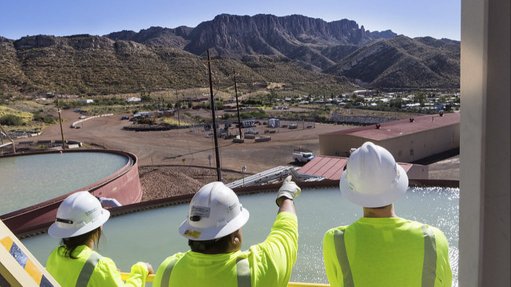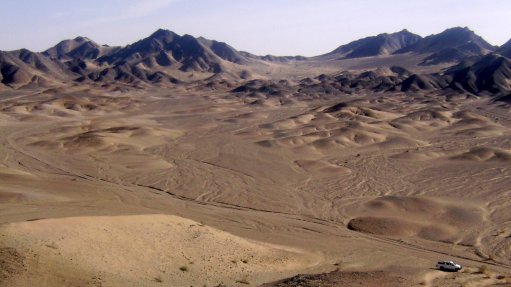‘Frack mining’ mooted as a future mining innovation


ADRIENNE RATMANSKY Frack mining combines the mining industry’s practice of in-situ leaching with the oil and gas industry’s hydraulic fracturing process
Miners currently face many challenges, from low commodity prices to the exhaustion of accessible high-quality orebodies and high development costs. However, by drawing on the oil and gas industry’s process of hydraulic fracturing, or fracking, miners may have new ways to tackle those problems through the technique of frack mining, says professional services company Accenture project controls consultant Adrienne Ratmansky.
She explains that frack mining combines the mining industry’s practice of in situ leaching with the oil and gas industry’s hydraulic fracturing process.
“In situ leaching is a well-established process that involves the drilling of vertical wells to pump leaching solution into an orebody. Once the solution is impregnated with the mineral, it is pumped out through a recovery well,” Ratmansky describes.
She says that hydraulic fracturing is used frequently in the US, Russia and China and involves the drilling of horizontal directional wells, which are then injected with pressurised chemicals to create small fissures in the rock, freeing the oil or gas for extraction.
Ratmansky notes that, with frack mining, a one directional borehole could be drilled from a central well and guided to the top of an ore vein, with another being drilled into the base of the ore vein.
She states that the orebody would be pressurised, causing fissures. An in situ leaching solution could then be pumped into the top borehole and gravity would carry the solution down through the fissures, picking up targeted minerals along the way.
The saturated solution would drain into the lower borehole and pool in a common extraction well, where it could be pumped to the surface. Ratmansky highlights that, with this technique, the solution does not have to erode a path to the recovery well, as it does with in situ leaching, as the path is provided by the fissures.
“This approach offers potentially lower costs, compared to in situ leaching. For example, to cover a surface area of about 3 800 m2, a typical in situ leaching operation would require three extraction wells and 13 inlet wells (16 wells in total), with a submersible pump in each of the extraction wells for transporting the solution to the surface (assuming a distance of 20 m from inlet well to extraction well).”
Meanwhile, she says a frack mining operation would require just one inlet well and one outlet well to cover a similar area. Ratmansky points out that only one submersible pump would be needed to drain the outlet well. The inlet and outlet wells would be located as a central “hub”, with spokes of 12 horizontal 35-m-long lines, each with upper and lower wells, emanating from them.
This would mean that there would be 24 horizontally drilled sections in total. Moreover, she points out that in these two scenarios, the in situ leaching operation would require total drilling of 3 200 m, while the frack mining approach would require only 1 240 m (assuming a well depth of 200 m).
Ratmansky highlights that, if drilling costs were $80/m, the total cost of drilling would be $256 000 and $99 200, respectively.
Other cost benefits are also likely. For example, while experiments have not yet been done to determine maximum spoke length, increasing the spoke length would enable production of a larger surface area. This would further improve the cost advantage over in situ leaching.
Frack mining is also likely to require a smaller footprint than in situ leaching, which could lead to relatively lower mine development and closure costs, she adds.
Additionally, Ratmansky highlights that, with the hub-and-spoke pattern, operation could begin after the completion of just one set of upper and lower horizontal spokes, with additional spokes coming on line as they are completed.
She believes that this arrangement could enable miners to start generating cash sooner to cover initial capital costs, with future expansion becoming an operational cost. “This would improve project economics and allow miners to increase production when required by the market,” Ratmansky enthuses.
Moreover, she contends that, beyond lower costs, frack mining could also ensure higher production rates, as the fissuring process would increase the surface area between the ore and leaching solution, thus increasing the amount of ore being picked up by the solution.
Ratmansky says that frack mining could be valuable in operations that currently use in situ leaching, such as uranium, copper and potash mining, as it could also enable miners to cost-effectively extract lower-grade ores in traditional, less-remote locations.
She also notes that, as environmentally safer dissolving solutions are developed, the process could be expanded to other minerals, such as gold.
“Overall, the approach is a potentially promising hybrid application of existing and well-known technologies and is an opportunity that warrants consideration, as miners look for innovative solutions to the industry’s current challenges,” Ratmansky concludes.
Comments
Press Office
Announcements
What's On
Subscribe to improve your user experience...
Option 1 (equivalent of R125 a month):
Receive a weekly copy of Creamer Media's Engineering News & Mining Weekly magazine
(print copy for those in South Africa and e-magazine for those outside of South Africa)
Receive daily email newsletters
Access to full search results
Access archive of magazine back copies
Access to Projects in Progress
Access to ONE Research Report of your choice in PDF format
Option 2 (equivalent of R375 a month):
All benefits from Option 1
PLUS
Access to Creamer Media's Research Channel Africa for ALL Research Reports, in PDF format, on various industrial and mining sectors
including Electricity; Water; Energy Transition; Hydrogen; Roads, Rail and Ports; Coal; Gold; Platinum; Battery Metals; etc.
Already a subscriber?
Forgotten your password?
Receive weekly copy of Creamer Media's Engineering News & Mining Weekly magazine (print copy for those in South Africa and e-magazine for those outside of South Africa)
➕
Recieve daily email newsletters
➕
Access to full search results
➕
Access archive of magazine back copies
➕
Access to Projects in Progress
➕
Access to ONE Research Report of your choice in PDF format
RESEARCH CHANNEL AFRICA
R4500 (equivalent of R375 a month)
SUBSCRIBEAll benefits from Option 1
➕
Access to Creamer Media's Research Channel Africa for ALL Research Reports on various industrial and mining sectors, in PDF format, including on:
Electricity
➕
Water
➕
Energy Transition
➕
Hydrogen
➕
Roads, Rail and Ports
➕
Coal
➕
Gold
➕
Platinum
➕
Battery Metals
➕
etc.
Receive all benefits from Option 1 or Option 2 delivered to numerous people at your company
➕
Multiple User names and Passwords for simultaneous log-ins
➕
Intranet integration access to all in your organisation



















